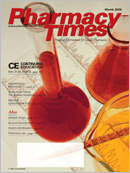Publication
Article
Pharmacy Times
New Drug Class to Target Glucose and Lipids
Author(s):
With the recent development ofsuch drugs as insulin analogues,insulin glargine (Lantus),insulin detemir (Levemir), exenatide(Byetta), and pramlintide acetate (Symlin),this is truly a new era for treating diabetes.The development of another newclass of drugs, the peroxisome proliferator-activated receptor (PPAR) alpha/gamma agonists, confirms that this newera is not about to end anytime soon.This class, if approved, will target not onlyglycemic control, but also one of thecomorbidities that often plagues personswith type 2 diabetes—dyslipidemia. Withmore than 20 million patients with diabetesin the United States alone, newtreatment modalities are a welcomeaddition to the current strategies formanaging this disease.
Two PPAR agonists that are currentlyavailable, rosiglitazone and pioglitazone(glitazones), are PPAR gamma agoniststhat primarily affect glucose levels. PPARgamma is known to be important in theregulation of glucose. The glitazoneslead to insulin sensitization through thebinding to and activation of PPARgamma. Whereas the main effect of theglitazones is glucose lowering, somerecent small studies demonstrate thatpioglitazone also may have a favorableeffect in reducing small, dense low-densitylipoprotein (LDL) particles and raisinghigh-density lipoprotein (HDL) levels.A second PPAR isotype, PPAR alpha,has been recognized as one that regulatesdifferent target genes, most ofwhich are involved in lipid metabolism.PPAR alpha is expressed primarily in theliver and skeletal muscle.
The new class of medications, PPARdual agonists, activates both PPARalpha and PPAR gamma and may leadto a combination effect on insulin sensitizationplus lipid lowering by increasingfatty acid oxidation. Muraglitazar isthe first dual PPAR agonist to be consideredfor approval by the FDA. Earlyresults from a 2-year phase 3 studylook very promising.1-3
The initial trial included 985 patientsrandomized to 1 of 4 different doses ofmuraglitazar (0.5-20 mg) or to pioglitazone15 mg daily. An extension studyincluded 88 type 2 diabetes patients whocontinued on muraglitazar 5 mg daily.These patients achieved an averagehemoglobin A1C level of 6.5% within 4months after beginning the drug andmaintained that level of control throughoutthe 2 years. Lipid results in that groupincluded an average triglyceride reductionof 28.4% and an average HDLincrease of 19.2%. No significant effectson LDL concentrations were seen.
The most common forms of dyslipidemiapresent in patients with type 2 diabetesare elevated triglycerides anddecreased HDL. Although these levelsare just markers, it is well understoodfrom multiple studies that dyslipidemiamust be managed in patients with diabetesin order to reduce the risk of cardiovasculardisease.
On other secondary end points,muraglitazar was associated with significantreductions from baseline in fastingplasma glucose, fasting plasma insulin,apolipoprotein B, free fatty acid, and non-HDL cholesterol levels. Muraglitazartreatment also was associated withincreased insulin sensitivity, as measuredby a decrease in homeostasis modelassessment of insulin resistance.
Adverse effects with muraglitazar aresimilar to those with PPAR gamma agonists.They include weight gain (2-4 kg),peripheral edema (10% incidence), andchronic heart failure exacerbation. Amajor concern is that an increased incidenceof adverse cardiovascular events(myocardial infarction, stroke, transientischemic attack) has been observed, andmore safety studies need to be conductedto analyze the potential cardiovascularrisks of this drug. No cases of hypoglycemiahave been observed. Hepatotoxicity,a concern with the PPARgamma agonists, thus far has not beenobserved.
Many patients with diabetes willrequire lipid-lowering therapy along withtheir medications for blood glucose control.The current drug therapies availablefor the treatment of dyslipidemia include3-hydroxy-3-methylglutaryl coenzyme Areductase inhibitors (statins), fibrates,niacin, bile acid resins, and cholesterolabsorption inhibitors. Although, if approved,the PPAR dual agonists are notlikely to replace current therapies available,they certainly will provide a newtreatment option for the multiple facetsof diabetes management.
Dr. Brian is a clinical specialist withCornerstone Health Care, HighPoint, NC.
For a list of references, send astamped, self-addressed envelope to:References Department, Attn. A. Stahl,Pharmacy Times, 241 Forsgate Drive,Jamesburg, NJ 08831; or send an e-mailrequest to: [email protected].

Newsletter
Stay informed on drug updates, treatment guidelines, and pharmacy practice trends—subscribe to Pharmacy Times for weekly clinical insights.






